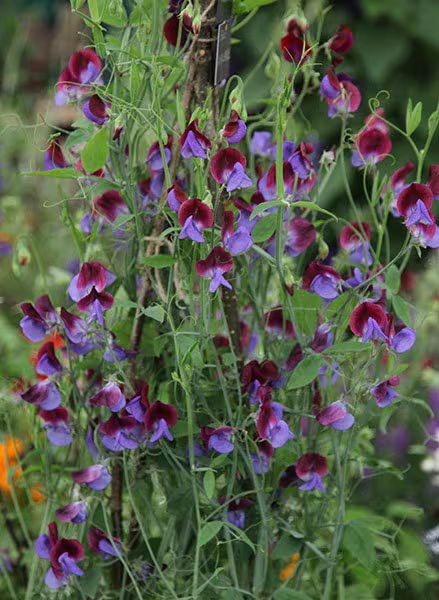
Sweet peas are one of the sweetest flowers (see what I did there). They have a beautiful fragrance and are delicate and fresh. I first decided to grow some when I watched a series on Floret Flowers website about how some varieties are in jeopardy of becoming extinct. Erin advocates for preserving some of these varieties and I was all in. This sweet peas 101 guide will hopefully pass on some of that spark and knowledge to get more people to want to know about and grow sweet peas of their own.

About Sweet Peas
- ANNUAL
- Zones 3-8
- Full to partial sun
- They need sun to bloom but don’t like the heat that comes from the late afternoon sun
- Well drained, slightly alkaline soil
- Blooms late spring – early summer
- 6-8′ tall, it is a vining plant and will need something to climb on
- Easily grown from seed
- Relatively pest resistant once past the seedling stage
- Very fragrant
- Pink, lavender, red, white, or blue flowers
- Can be grown in pots or in the ground near a trellis or archway
- Attracts beneficial pollinators
- Toxic to humans and pets if ingested

Maintenance
- Keep soil moist. Sweet peas don’t like to be soggy but they do like to have moist soil….like a wrung out sponge
- Plant them early in the season. Sweet peas don’t like to be hot so if you are in a warmer climate, plant where they will get some shade. If you are in a cooler climate, they can take a spot where it will be sunnier
- Fertilize weekly with bone meal or other fertilizer high in potassium or phosphate
- When seedling reaches 4″ tall, pinch back to 3″. This encourages more flower shoots to grow
- Keep spent flowers deadheaded and don’t be afraid to cut flowers for bouquets. The more you take the flowers, the more the plant will produce
- If you want more flowers, keep the plant from producing pods (seeds). Once it starts producing pods, it will stop flowering. Do this by deadheading spent flowers
- Give them something to climb otherwise they’ll flop over and look awful

Seeds and Reproduction
- Soak seeds for 24 hours before sowing
- If sowing in pots, give them lots of room to grow deep roots
- Cover with plastic dome or use humidity lid to keep soil moist and warm
- Pinch back when 4″-ish tall just above a leaf node. Usually pinching off about an inch
- Keep fertilized once they sprout with phosphorus and potassium
- Be careful when transplanting as they are a bit delicate
- Seeds can be saved at the end of the season when pods have formed
Favorites
Printable Info Sheet

Check out our other plant encyclopedia pages!











Recent Comments